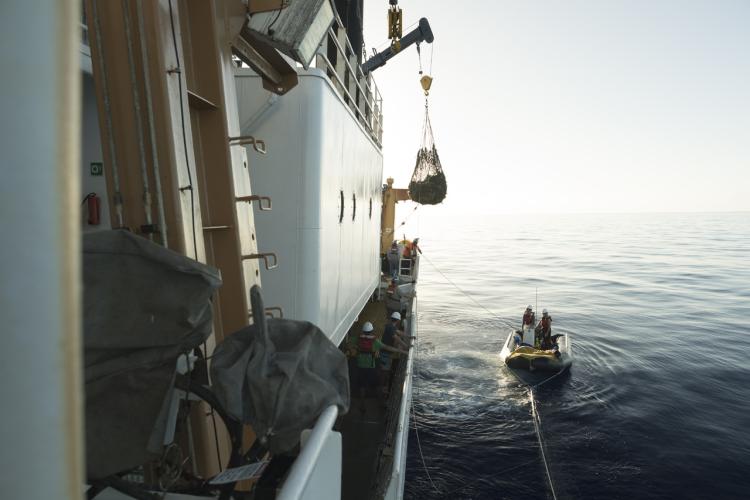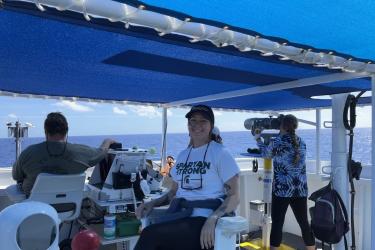Pearl and Hermes Atoll blew us out in a blustery squall. Hurricane Walaka brought some less than optimal weather conditions for our marine debris removal operations. We were expecting the storm for several days, thinking it would put a stop to our work on Tuesday and Wednesday, but the storm didn’t arrive until Wednesday evening. We launched the two bigger boats both days and managed to pull in a few thousand pounds of derelict fishing nets. By Wednesday evening it was clear that operations were out of the question for the next few days as the seas grew stormy.

The trusty NOAA Ship Oscar Elton Sette handled the turbulence soundly, but some of our marine debris team did not fare so well onboard in the swells. Our best option was to set a heading for Midway Atoll and arrive a day early. The only issue was that the seas grew even more violent as we left the shelter of the atoll. Fortunately, we made the journey through the night, but it wasn’t very easy to sleep when we were rolling across our beds every 30 seconds as the Sette took the swells head on.

All in all, our mission at Pearl and Hermes was a huge success. Our team came together with ambitious goals to pull tons of derelict fishing gear off the reefs and also complete several new scientific objectives. We installed satellite-tracking buoys on six different large floating nets to track their locations and movements through the atoll. We captured “structure from motion” photo mosaics from over 20 net removals to measure net scars on the reef and observe how the reef changes after the nets are removed. We took aerial imagery of survey sites to identify nets and improve maps of the reef. At the end of 10 days of operations in this pristine marine ecosystem, our team removed a total of 52,000 pounds of derelict fishing nets, reducing entanglement hazards for wildlife and helping restore healthy coral reefs.

This is a huge accomplishment and our team is very proud of our effort. It has been back-breaking work and our bodies feel it. But it has also been extremely rewarding, and that is why we love what we do. We spent 15 nights onboard the Sette, eating, sleeping, working, eating, living, eating, sleeping... and through that time we got to know the Sette’s crew really well. We are super thankful for all they have done to help make this leg of our mission possible and all the laughs shared along the way. This is just the beginning for us, though.
Next stop: Midway Atoll for three weeks of cleaning up land debris! Different environment, different debris types, different field operations, and the same motivation to clean the seas.
Meet the Blogger

Drew McWhirter
Drew attended the University of Washington School of Oceanography where he studied zooplankton and bull kelp in the Pacific Northwest. He learned to surf when he lived in Hawai‘i, which built the foundation of his fascination with the ocean. Beyond surfing, he enjoys anything involving water or a board of some sort. He values traveling, meeting new people and hearing their stories, exploring new places and cultures, and making a positive environmental impact. He is stoked to keep the oceans free of debris!
Follow us
Follow the team as we travel to the islands and atolls of the Northwestern Hawaiian Islands with photos and updates on our Story Map.
Partners
NOAA Fisheries marine debris project in the Pacific Islands region is supported by NOAA (Pacific Islands Fisheries Science Center, Pacific Islands Regional Office, Marine Debris Program, National Marine Sanctuaries, and the Damage Assessment Remediation and Restoration Program) in partnership with the University of Hawaii's Joint Institute for Marine and Atmospheric Research, National Fish and Wildlife Foundation, U.S. Fish and Wildlife Service, Midway Atoll National Wildlife Refuge, the State of Hawaii’s Department of Land and Natural Resources, and the Papahānaumokuākea Marine National Monument.

